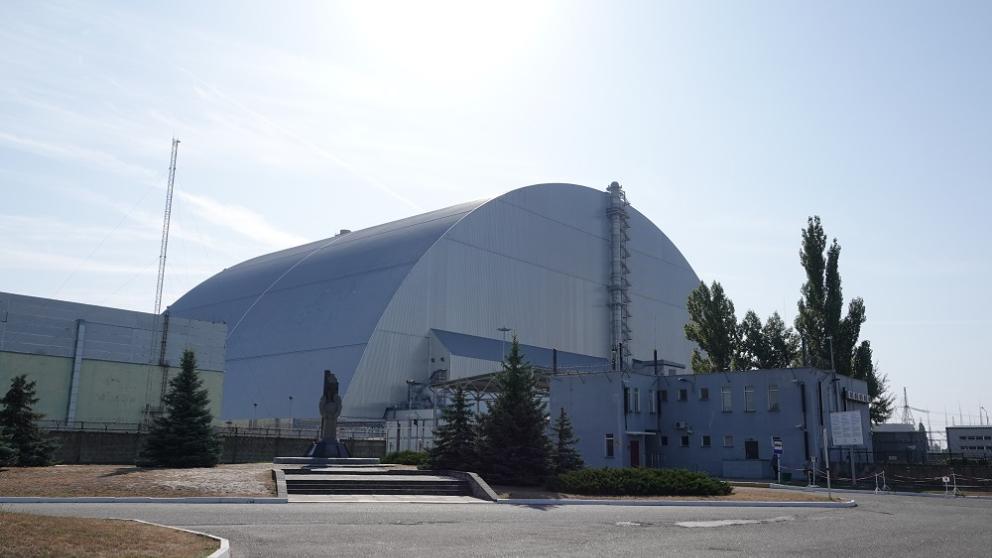Research: Military vehicles disturbing soil did not cause a Chornobyl radiation spike

A new study has found an apparent spike in radiation levels reported across the Chornobyl* Exclusion Zone was not caused by invading Russian military vehicles, as had become widely accepted, or by a leak from the former nuclear reactor or one of the radioactive waste storage facilities.
Research by the University of Salford and the UK Centre for Ecology & Hydrology has suggested that there may have been no significant radiation spike at all, but an inaccurate gamma dose reading. In the study, which is awaiting peer review, the researchers hypothesise that electro-magnetic frequency interference from military activities may have disrupted the Chornobyl base-station’s reception of wireless signals from the detectors located around the Exclusion Zone.
The Chornobyl Exclusion Zone is the abandoned area around the site of the 1986 accident at Chornobyl Reactor 4, an accident that caused the largest release of radioactivity to the environment in the history of nuclear power generation. The Chornobyl Exclusion Zone now contains an extensive nuclear waste legacy. As well as the radioactive material in the Chornobyl reactor building, there are radioactive waste stores, ‘temporary’ radioactive waste trenches and surface soils contaminated with radioactive material.
The Comprehensive Radiation Monitoring and Early Warning System (CRMS) for Chornobyl includes a network of 67 detectors that monitor the gamma radiation dose rates within this contaminated region. This monitoring network is an essential component of the controls in place to ensure safety and security of radioactive material in the Chornobyl Exclusion Zone.
On 24th/25th February 2022, increased gamma radiation dose rates were reported by the CRMS. This coincided with Russian military vehicles entering the Ukrainian part of the Chornobyl Exclusion Zone from neighbouring Belarus. It was speculated that contaminated soil resuspension by heavy vehicle movements or a leak from the Chornobyl Nuclear Power Plant complex may explain these apparent spikes in radiation dose rates. The original suggestion by scientists of the soil resuspension explanation was widely accepted and reported globally, but there was no validation of this hypothesis.
Using modelling and spatial analysis, researchers evaluated the suggested hypotheses to explain the apparent gamma dose rate increases, demonstrating that neither military vehicle-induced soil resuspension nor a leak from the Chornobyl Nuclear Power Plant are plausible. However, military electro-magnetic frequency interference may have disrupted the Chornobyl base-station’s reception of wireless signals from the CRMS network and this may potentially explain the anomalous dose rates recorded rather than an actual spike in radiation.
Lead author of the research, Professor Mike Wood from the University of Salford said: “Our findings disprove global media coverage of the increased radiation levels, we suggest instead that the cause may be military electro-magnetic frequency interference rather than a real change in the radiation situation within the Chornobyl Exclusion Zone.”
The UK Centre for Ecology & Hydrology’s Professor Nick Beresford, who co-authored the study added: “Importantly our paper indicates that a leak from the Chornobyl Nuclear Complex did not cause a spike in gamma dose rates. The Chornobyl Exclusion Zone is a unique area not only in terms of radiological contamination but also from the perspective of the range of wildlife found there and rewilding – we need to understand the impact of the war on all aspects of the Chornobyl Exclusion Zone.”
Read the full article.
For further commentary on this and other Chornobyl-related topics, follow @ProfMikeWood and @radioecology on X (formerly Twitter).
*Chornobyl is the Ukraine spelling of Chernobyl which is the Russian spelling
For all press office enquiries please email communications@salford.ac.uk.
Share:
